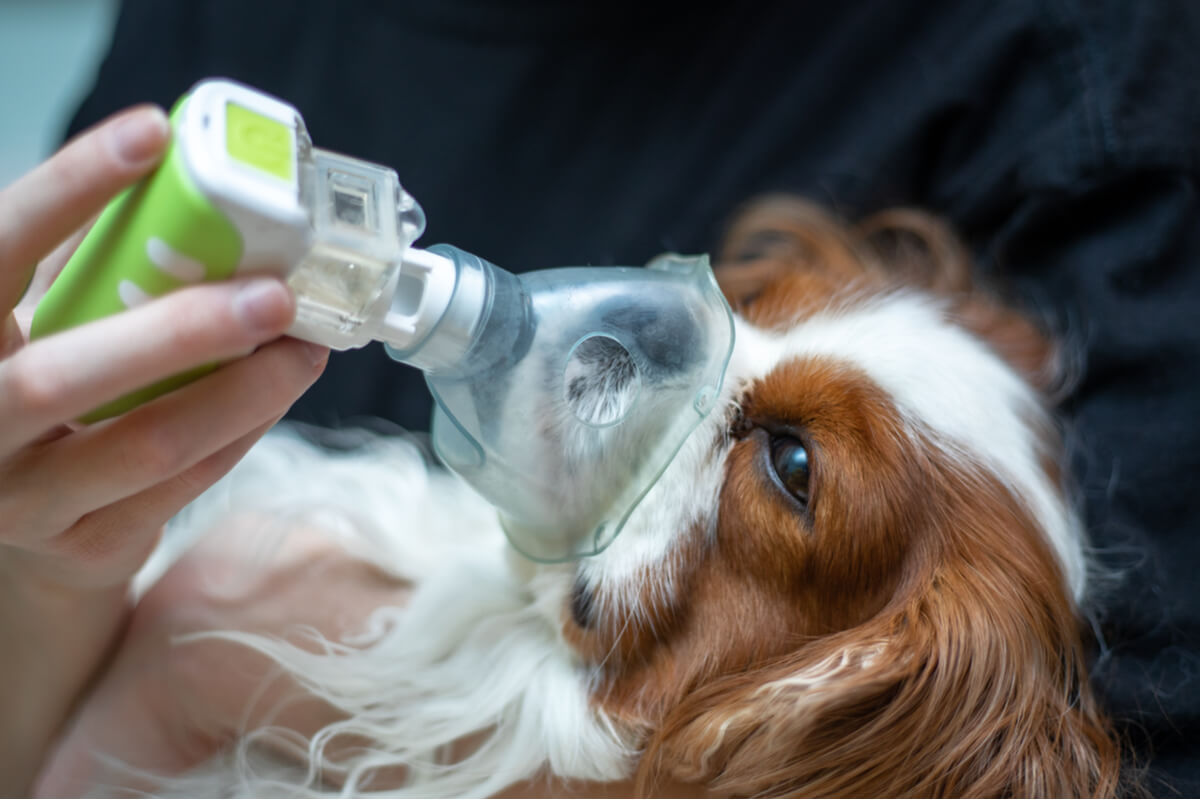What Is Emphysema in Dogs?


Written and verified by the biologist Cesar Paul Gonzalez Gonzalez
Respiratory diseases are a serious threat to any pet’s health. This is because they hinder the process of blood oxygenation, which causes problems in different body organs. Among these disorders, we find emphysema, which usually leaves severe sequelae that can cause serious problems in a dog.
Emphysema is a condition that hinders the breathing of dogs. For this reason, it’s considered part of the chronic obstructive pulmonary diseases (COPD). Read on and learn more about this disease.
What is emphysema?
Emphysema is caused by a condition of the respiratory system. This condition causes dogs to have trouble exhaling the air that enters their lungs, which causes breathing problems. The causes of this condition are diverse and we can identify at least 3 different forms of emphysema: alveolar, interstitial, and subcutaneous.

1. Alveolar emphysema
This type of emphysema is one of the most common in dogs, because the conditions take place directly in the lungs. During this condition, the alveolar sacs that are responsible for blood oxygenation become “swollen”. Because of this, these structures can’t do their job and prevent the animal from breathing correctly.
Alveolar emphysema is usually caused by a secondary condition. However, some cases are the result of a chronic obstructive disease, so the dog has to live with medication for the rest of its life.
2. Interstitial emphysema
Interstitial emphysema causes a “bubble” of air to lodge outside the lungs. This problem occurs due to an injury to any part of the respiratory system, which allows some of this gas to leak out. Consequently, it escapes into the connective tissue and clumps around the organs.
The damage caused by this emphysema depends on the amount of air in the bubble, as all internal structures are damaged due to the pressure. This situation causes different organs to be compromised. Therefore, the symptoms and treatments are somewhat more complex than in other cases.
3. Subcutaneous emphysema
This type of emphysema is quite rare, as very specific conditions are needed for it to appear. In general, it behaves like interstitial emphysema, but the air accumulates almost under the skin (and is considered subcutaneous). It also causes different medical conditions depending on the area where the “bubbles” are located.
What causes emphysema?
Emphysema in dogs is caused by different reasons in each case. However, most are caused by a pre-existing respiratory disease. Some of the most common causes are listed below:
- Bronchitis: An inflammation of the bronchial tubes that, if left untreated, can lead to alveolar emphysema.
- Trauma: Any strong blow near the abdominal region can lead to emphysema. This also includes some accidents such as road traffic accidents.
- Parasites: Some endoparasites are able to invade the lungs and reach the alveoli, and they can cause inflammation that obstructs the alveolar mechanism.
- Cancer: Invasive cancer processes are capable of causing a lung lesion and cause this disease.
- Perforating wounds: Any deep wound that perforates any part of the respiratory system can cause emphysema. Bites are responsible for most of these cases.
- Genetic conditions: A disease called congenital lobar emphysema is a product of the dog’s own genetics. This condition causes a malformation of the lungs that will prevent dogs from breathing.
- Surgeries: After surgery, dogs can suffer from interstitial emphysema.
Symptoms of emphysema
The most obvious symptoms of the condition are shortness of breath and coughing. However, there are other warning signs that can signal the presence of emphysema. The following list contains some of these signs:
- Weight loss
- Lethargy
- Low resistance to exercise
- Weakness
- Loss of appetite
- Fast heart rate
- Lumps in one or more parts of the body
Diagnosing emphysema in dogs
The veterinarian must rule out a long list of possible pathologies, so physical examinations, laboratory tests, and x-rays will be performed on the patient. Complementary studies can also be requested in order to help in the diagnosis. This allows a vet to determine the cause of the pathology and assign the appropriate treatment.
Keep in mind that the diagnosis consists of detecting the emphysema and discovering the problem that caused the condition. Therefore, only a professional in animal health is able to make the corresponding review. Never try to diagnose your pet’s illness.
Treatment of canine emphysema
The treatment of this pathology will depend on the severity of the case, as the dog may need to be hospitalized in order to provide oxygenation. The first part of the follow-up is focused on stabilizing the dog’s symptoms. In order to do this, bronchodilator and anti-inflammatory drugs are used, which help to improve breathing.
After that, the surgeon will analyze the damage in the lungs, and will remove the parts that have been atrophied (in a process known as lobectomy). The affected organs are also treated and given what they need to recover. Finally, the cause that caused the emphysema in the first place is dealt with.

Dogs won’t have serious long-term sequelae if they’re diagnosed early. This includes dogs that need surgery, as recovery isn’t usually too complicated. In general, you will need to restrict the exercise they get and give them plenty of rest. However, be sure to always follow all the instructions your veterinarian gives you.
Respiratory diseases are a serious threat to any pet’s health. This is because they hinder the process of blood oxygenation, which causes problems in different body organs. Among these disorders, we find emphysema, which usually leaves severe sequelae that can cause serious problems in a dog.
Emphysema is a condition that hinders the breathing of dogs. For this reason, it’s considered part of the chronic obstructive pulmonary diseases (COPD). Read on and learn more about this disease.
What is emphysema?
Emphysema is caused by a condition of the respiratory system. This condition causes dogs to have trouble exhaling the air that enters their lungs, which causes breathing problems. The causes of this condition are diverse and we can identify at least 3 different forms of emphysema: alveolar, interstitial, and subcutaneous.

1. Alveolar emphysema
This type of emphysema is one of the most common in dogs, because the conditions take place directly in the lungs. During this condition, the alveolar sacs that are responsible for blood oxygenation become “swollen”. Because of this, these structures can’t do their job and prevent the animal from breathing correctly.
Alveolar emphysema is usually caused by a secondary condition. However, some cases are the result of a chronic obstructive disease, so the dog has to live with medication for the rest of its life.
2. Interstitial emphysema
Interstitial emphysema causes a “bubble” of air to lodge outside the lungs. This problem occurs due to an injury to any part of the respiratory system, which allows some of this gas to leak out. Consequently, it escapes into the connective tissue and clumps around the organs.
The damage caused by this emphysema depends on the amount of air in the bubble, as all internal structures are damaged due to the pressure. This situation causes different organs to be compromised. Therefore, the symptoms and treatments are somewhat more complex than in other cases.
3. Subcutaneous emphysema
This type of emphysema is quite rare, as very specific conditions are needed for it to appear. In general, it behaves like interstitial emphysema, but the air accumulates almost under the skin (and is considered subcutaneous). It also causes different medical conditions depending on the area where the “bubbles” are located.
What causes emphysema?
Emphysema in dogs is caused by different reasons in each case. However, most are caused by a pre-existing respiratory disease. Some of the most common causes are listed below:
- Bronchitis: An inflammation of the bronchial tubes that, if left untreated, can lead to alveolar emphysema.
- Trauma: Any strong blow near the abdominal region can lead to emphysema. This also includes some accidents such as road traffic accidents.
- Parasites: Some endoparasites are able to invade the lungs and reach the alveoli, and they can cause inflammation that obstructs the alveolar mechanism.
- Cancer: Invasive cancer processes are capable of causing a lung lesion and cause this disease.
- Perforating wounds: Any deep wound that perforates any part of the respiratory system can cause emphysema. Bites are responsible for most of these cases.
- Genetic conditions: A disease called congenital lobar emphysema is a product of the dog’s own genetics. This condition causes a malformation of the lungs that will prevent dogs from breathing.
- Surgeries: After surgery, dogs can suffer from interstitial emphysema.
Symptoms of emphysema
The most obvious symptoms of the condition are shortness of breath and coughing. However, there are other warning signs that can signal the presence of emphysema. The following list contains some of these signs:
- Weight loss
- Lethargy
- Low resistance to exercise
- Weakness
- Loss of appetite
- Fast heart rate
- Lumps in one or more parts of the body
Diagnosing emphysema in dogs
The veterinarian must rule out a long list of possible pathologies, so physical examinations, laboratory tests, and x-rays will be performed on the patient. Complementary studies can also be requested in order to help in the diagnosis. This allows a vet to determine the cause of the pathology and assign the appropriate treatment.
Keep in mind that the diagnosis consists of detecting the emphysema and discovering the problem that caused the condition. Therefore, only a professional in animal health is able to make the corresponding review. Never try to diagnose your pet’s illness.
Treatment of canine emphysema
The treatment of this pathology will depend on the severity of the case, as the dog may need to be hospitalized in order to provide oxygenation. The first part of the follow-up is focused on stabilizing the dog’s symptoms. In order to do this, bronchodilator and anti-inflammatory drugs are used, which help to improve breathing.
After that, the surgeon will analyze the damage in the lungs, and will remove the parts that have been atrophied (in a process known as lobectomy). The affected organs are also treated and given what they need to recover. Finally, the cause that caused the emphysema in the first place is dealt with.

Dogs won’t have serious long-term sequelae if they’re diagnosed early. This includes dogs that need surgery, as recovery isn’t usually too complicated. In general, you will need to restrict the exercise they get and give them plenty of rest. However, be sure to always follow all the instructions your veterinarian gives you.
All cited sources were thoroughly reviewed by our team to ensure their quality, reliability, currency, and validity. The bibliography of this article was considered reliable and of academic or scientific accuracy.
- Akhtardanesh, B., Azari, O., & Vosough, D. (2007). Uncomplicated generalized subcutaneous emphysema in a dog. Iranian journal of veterinary surgery, 2(5), 93-97.
- Billet, J. P., & Sharpe, A. (2002). Surgical treatment of congenital lobar emphysema in a puppy. Journal of small animal practice, 43(2), 84-87.
- Mass, B., Ikeda, T., Meranze, D. R., Weinbaum, G., & Kimbel, P. (1972). Induction of experimental emphysema: cellular and species specificity. American Review of Respiratory Disease, 106(3), 384-391.
- Snider, G. L., Lucey, E. C., & Stone, P. J. (1986). Animal models of emphysema. American Review of Respiratory Disease, 133(1), 149-169.
- Han, H. J., & Kim, J. H. (2019). Concurrent pulmonary hypoplasia and congenital lobar emphysema in a young dog with tension pneumothorax: a rare congenital pulmonary anomaly. Acta Veterinaria Scandinavica, 61(1), 1-6.
- Vicens, B., Reventós, J., & Concustell, E. (1977). Estudio de las alteraciones de las propiedades tensioactivas del surfactante pulmonar del perro por la produccion de un enfisema experimental papainico. Archivos de Bronconeumología, 13(3), 168-173.
This text is provided for informational purposes only and does not replace consultation with a professional. If in doubt, consult your specialist.








